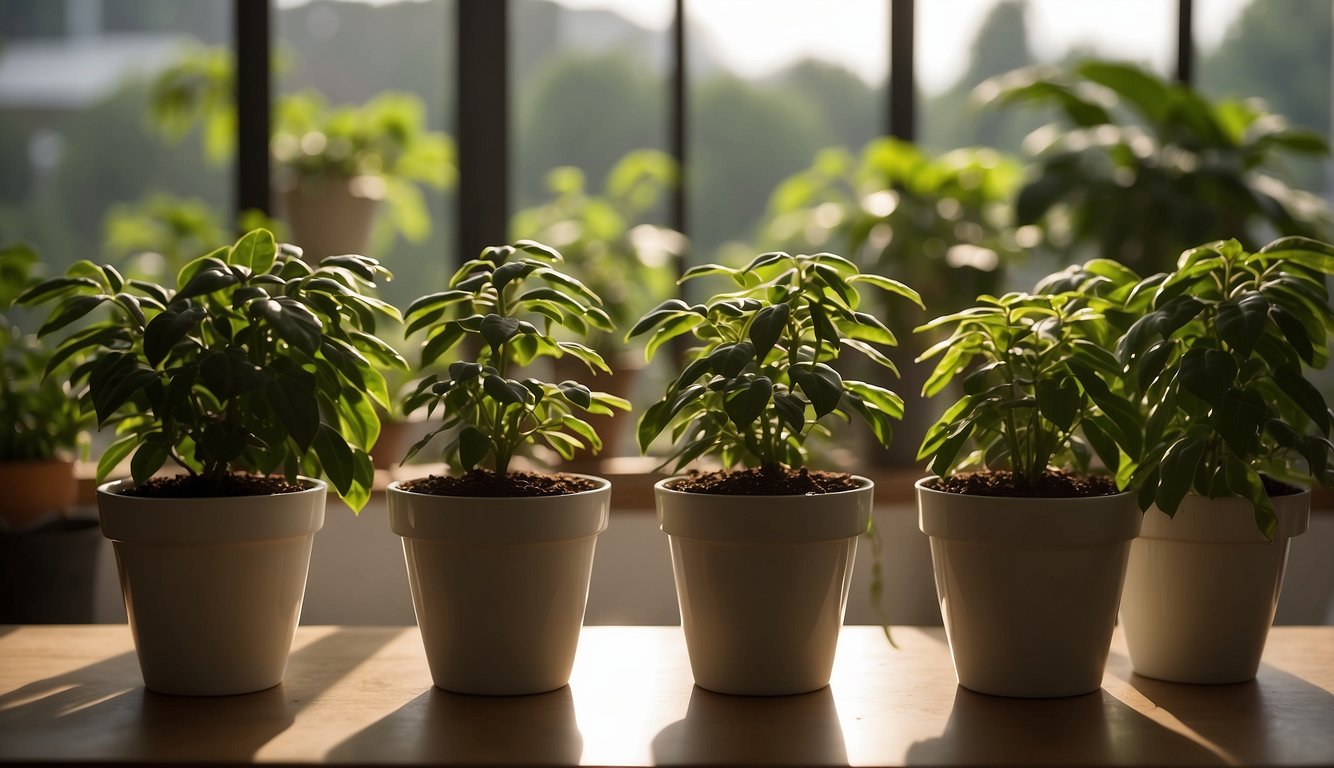TheHerbProf.com is a treasure trove of knowledge for those interested in natural healing and herbal remedies. The website is run by Paul Johnston MD. A naturopathic who has not only received extensive education in the field but also has personal experience in self-healing.
Growing coffee plants indoors can be a fun and rewarding experience for coffee lovers who want to enjoy the taste and aroma of freshly brewed coffee without leaving their homes.
Whether you live in a cold climate, don’t have access to outdoor space, or simply want to experiment with growing your own coffee plants, indoor coffee gardening can be a great way to get started.
To grow coffee plants indoors, you will need to create the right growing conditions and choose the right coffee plant variety.
Coffea arabica is the most popular coffee plant for indoor gardening, but other varieties such as Coffea canephora and Coffea liberica can also be grown indoors.
Coffee plants require a warm, humid environment with bright, indirect light and well-draining soil.
You will also need to water your coffee plant regularly and fertilize it every few weeks during the growing season.
If you are new to indoor gardening or coffee plant care, don’t worry.
With the right information and a little bit of patience, anyone can grow coffee plants indoors successfully.
In this article, I will provide you with everything you need to know about growing coffee plants indoors, from choosing the right coffee plant variety to creating the perfect growing conditions. So, let’s get started!
Choosing the Right Coffee Plant Variety – Growing Coffee Plants Indoors
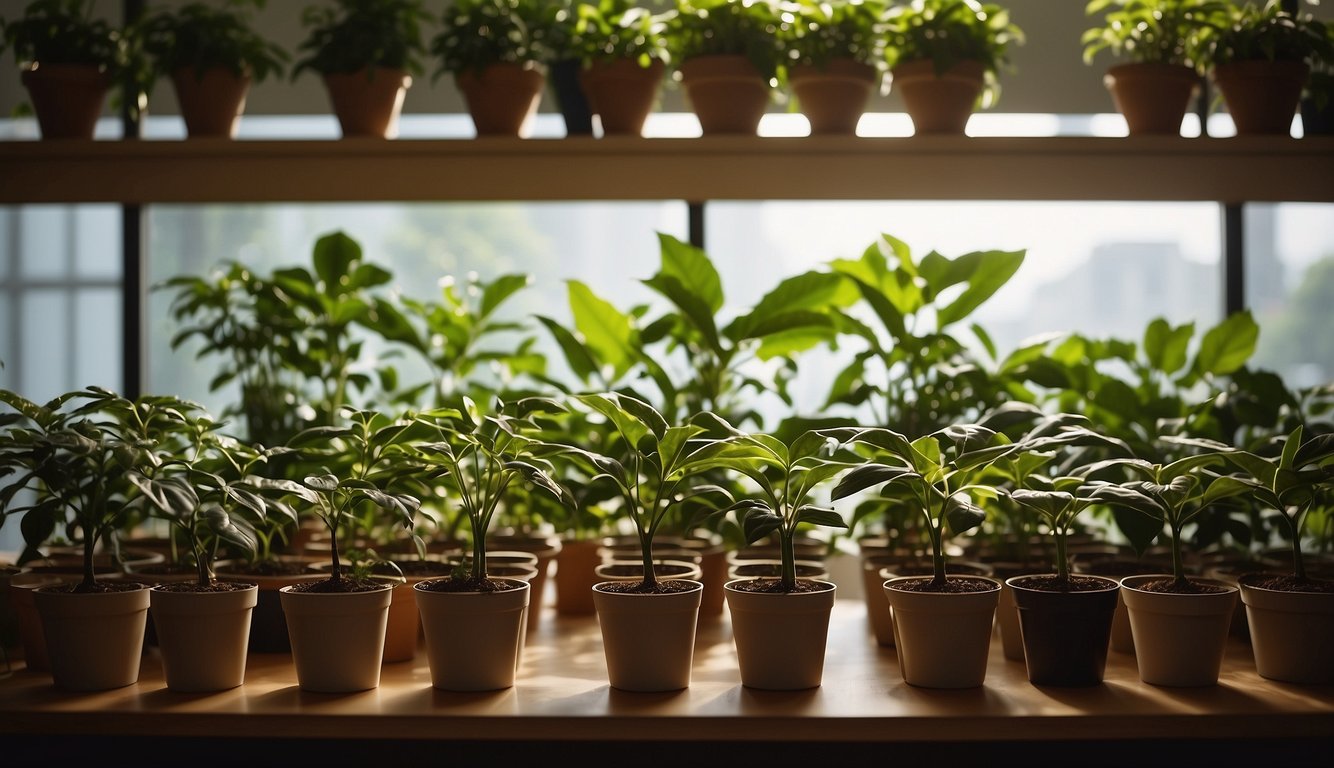
Growing coffee plants indoors can be a rewarding experience, but it’s important to choose the right variety to ensure success. Here are some factors to consider when selecting a coffee plant for indoor growing.
Growing Coffee Plants Indoors – Arabica vs. Robusta
Arabica and Robusta are the two main varieties of coffee plants. Arabica is the most popular variety, known for its high-quality beans and delicate flavor. Robusta, on the other hand, has a stronger, harsher taste and is often used in blends and instant coffee.
When it comes to growing coffee plants indoors, both varieties can be grown successfully. However, Arabica is generally considered to be more suitable for indoor growing due to its smaller size and lower light requirements.
Dwarf Varieties for Indoors
If you’re short on space, you might want to consider a dwarf coffee plant variety.
Coffea arabica ‘Nana’ is a popular dwarf variety that only grows up to 12 inches tall, making it an ideal choice for indoor growers.
Another option is Coffea charrieriana, a recently discovered dwarf variety that is native to Cameroon.
Fundamentals of Indoor Coffee Plant Care
Growing coffee plants indoors can be a rewarding experience, but it requires proper care and attention to ensure that the plants thrive. In this section, I will cover the fundamental aspects of indoor coffee plant care, including optimal temperature and humidity, light requirements, watering techniques, soil and drainage, and fertilizing schedule.
Optimal Temperature and Humidity
Coffee plants are native to tropical regions, and they thrive in warm and humid environments.
To ensure that your indoor coffee plants grow well, maintain a room temperature between 65°F and 80°F.
You can use a humidifier to increase the humidity levels around the plants, or you can place a tray of water near the plants to increase the moisture in the air.
Light Requirements
Coffee plants require bright, indirect light to grow well. Place your plants near a window that receives dappled light, but avoid placing them in direct sunlight, as this can scorch the leaves.
If you don’t have a suitable window, you can use grow lights to provide your plants with the light they need.
Watering Techniques – Growing Coffee Plants Indoors
When it comes to watering your indoor coffee plants, it’s important to strike a balance between keeping the soil moist and avoiding overwatering.
Coffee plants prefer slightly acidic soil that is moist but well-drained.
Water your plants when the top inch of soil feels dry to the touch, and make sure that the pot has drainage holes to allow excess water to escape.
Soil and Drainage
The type of soil you use for your indoor coffee plants is crucial for their growth and health.
Use a rich, peat-based, slightly acidic potting soil amended with organic matter to provide your plants with the nutrients they need.
Good drainage is also essential, as coffee plants are susceptible to root rot if the soil is too wet for too long.
Fertilizing Schedule
Indoor coffee plants require regular fertilization to ensure that they have the nutrients they need to grow and thrive.
Use a balanced, water-soluble fertilizer every two to four weeks during the growing season, and reduce the frequency during the winter months when the plants are dormant.
Be careful not to over-fertilize, as this can cause damage to the plants.
Propagation and Planting – Growing Coffee Plants Indoors
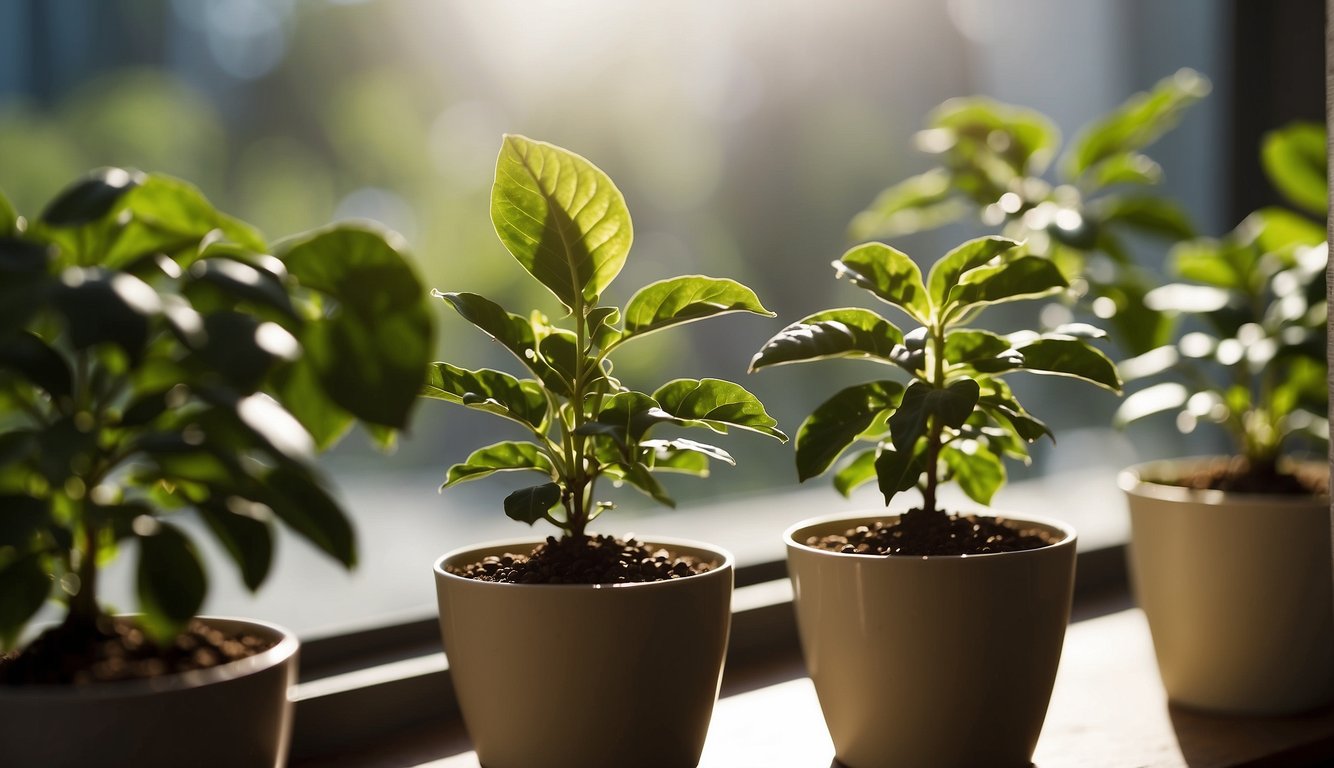
Growing coffee plants can be a rewarding experience, especially when you propagate and plant them yourself. There are two main methods for propagating coffee plants: growing from seeds and starting from cuttings.
Growing From Seeds
Growing coffee plants from seeds is a relatively simple process. Begin by obtaining fresh coffee seeds from a local coffee farm or nursery.
Soak the seeds in water for 24 hours to soften the outer shell and improve germination.
Next, fill a seed tray or small pots with well-draining potting mix. Plant the seeds about 1 inch deep and water them thoroughly.
Keep the soil moist and warm, ideally around 75°F, and within 2-3 weeks, you should start to see the seeds germinate.
Once the seedlings have grown to about 3-4 inches tall, you can transplant them into a larger nursery pot filled with compost. Keep them in a bright, warm location, but avoid direct sunlight.
Starting From Cuttings – Growing Coffee Plants Indoors
Starting coffee plants from cuttings is another popular propagation method. Begin by taking a cutting from an established coffee plant.
Choose a healthy stem that is 6-8 inches long, and make sure it has at least three leaves.
Use pruning shears to cut the stem at an angle just below a node (a small bump on the stem where the leaves grow). Remove the bottom leaf from the stem, leaving only two leaves at the top.
Dip the cut end of the stem in rooting hormone, and plant it in a pot filled with well-draining potting mix.
Water the cutting thoroughly and cover the pot with a plastic bag to create a humid environment.
Keep the pot in a warm, bright location, but avoid direct sunlight. Within a few weeks, the cutting should start to grow roots and new leaves.
Once the cutting has established roots, you can repot it into a larger nursery pot filled with compost.
Keep the soil moist and warm, and within a few months, your coffee plant should be ready to be transplanted into a larger container.
Pruning and Maintenance – Growing Coffee Plants Indoors
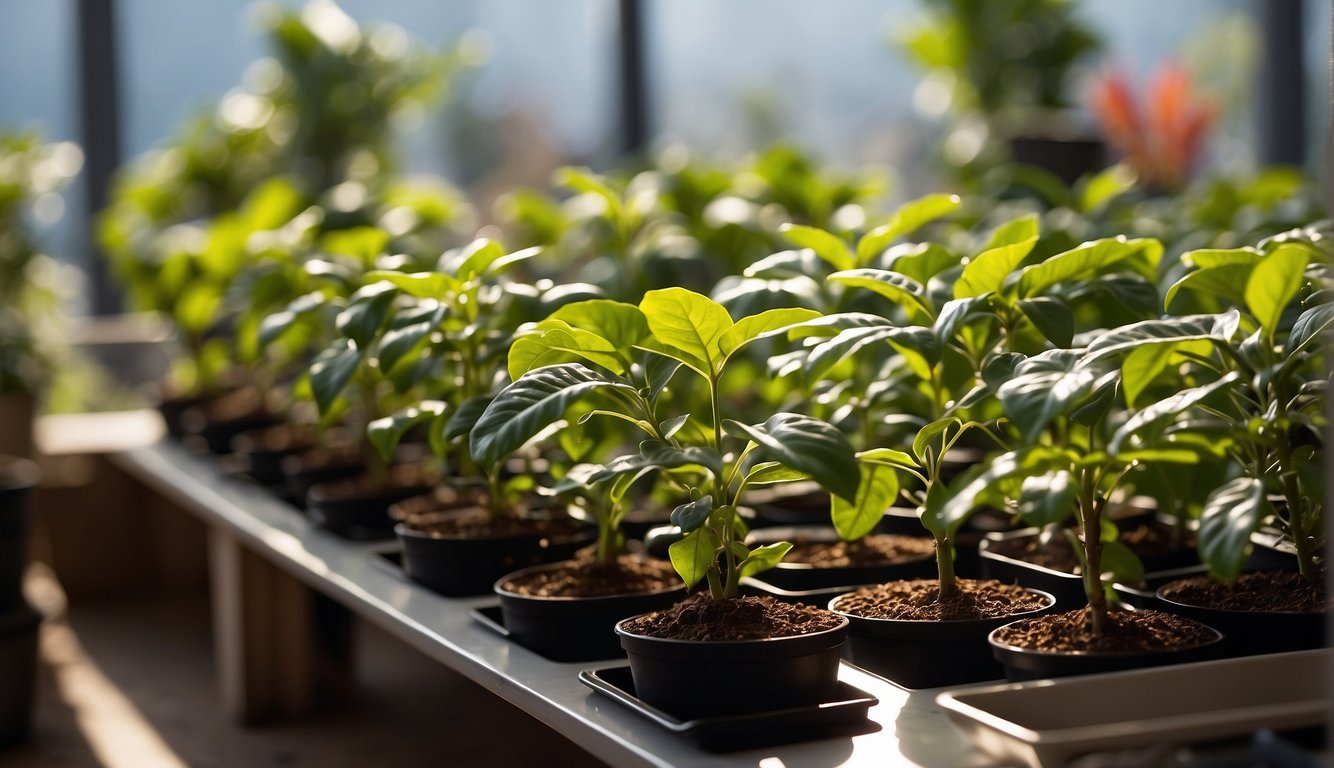
As with any plant, pruning and maintenance are essential to keep your coffee plant healthy and thriving. In this section, I will cover the techniques for pruning your coffee plant and managing its growth.
Pruning Techniques
Pruning your coffee plant is essential to maintain its shape and promote healthy growth.
The best time to prune your coffee plant is during the spring months.
Using clean, sharp pruning shears, cut the stem at a 45-degree angle, ¼-inch (6.4 mm) above where the leaf attaches to the stem (axil). This technique will help maintain a fuller, bushy appearance and generally shape the plant.
It is also essential to remove any dead or diseased leaves and branches to prevent the spread of disease.
Be sure to disinfect your pruning shears with rubbing alcohol before and after use to prevent the spread of disease.
Repotting and Growth Management – Growing Coffee Plants Indoors
As your coffee plant grows, you may need to repot it to a larger container to accommodate its increasing root system.
When repotting, be sure to use a well-draining potting mix and a container with drainage holes to prevent waterlogging.
To manage the growth of your coffee plant, you can also use pruning techniques to keep it at a manageable height.
If your coffee plant is getting too tall, you can cut it back to a more manageable size. Be sure to only cut back to a healthy branch or node to promote healthy growth.
Pest and Disease Control – Growing Coffee Plants Indoors
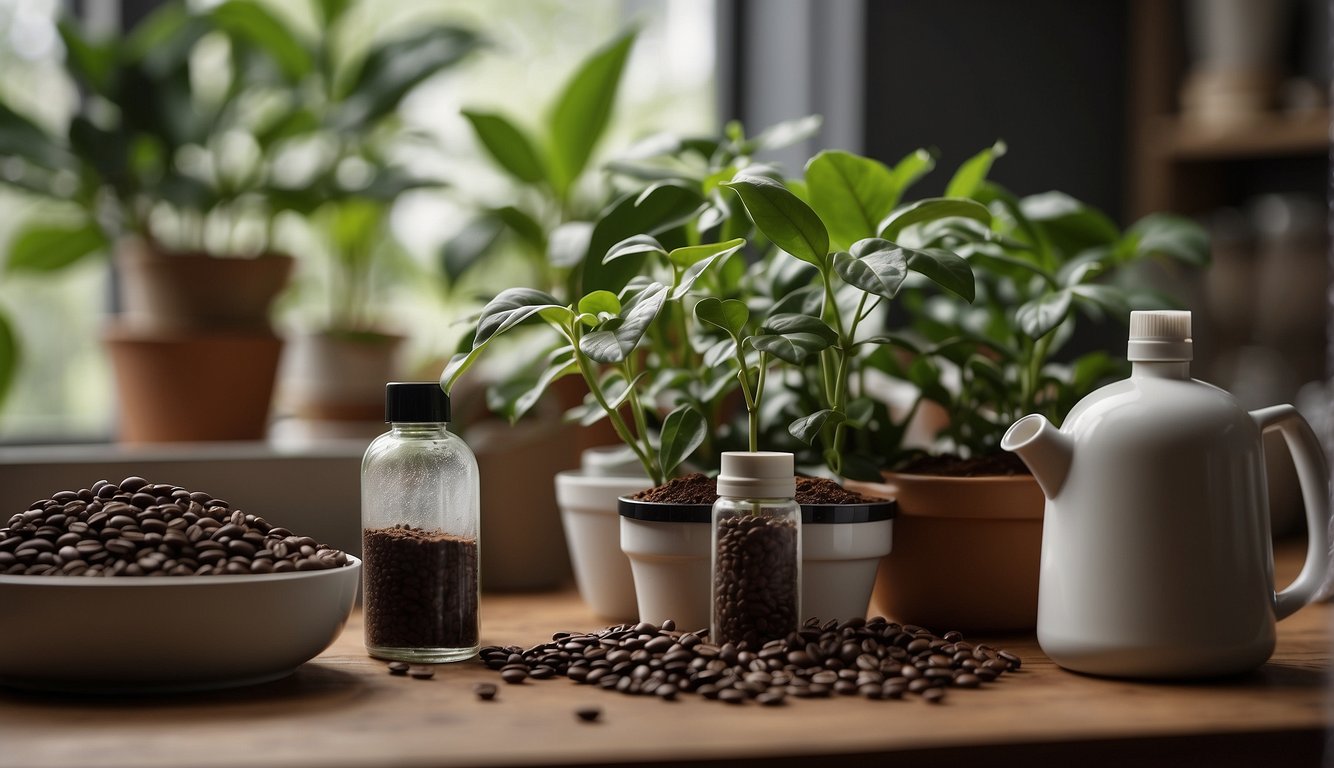
Growing coffee plants indoors requires vigilant pest and disease control. Here are some tips to help keep your coffee plants healthy and pest-free.
Common Pests
Coffee plants are susceptible to a variety of pests, including mites, mealybugs, and aphids.
These pests can cause damage to the leaves and stems of the plant, and can even spread to other plants in your home.
To control these pests, you can use neem oil, which is a natural insecticide.
Neem oil can be applied to the plant leaves and stems with a cotton swab or spray bottle.
Another option is to use insecticidal soap, which is a safe and effective way to control pests without harming the plant.
Dealing with Diseases
Coffee plants can also be affected by various diseases, such as spider mites and fungal infections.
These diseases can cause discoloration, wilting, and even death of the plant.
To prevent these diseases, it is important to maintain good air circulation around the plant and avoid overwatering.
Adding organic matter to the soil can also help to prevent fungal infections.
Flowering and Harvesting – Growing Coffee Plants Indoors
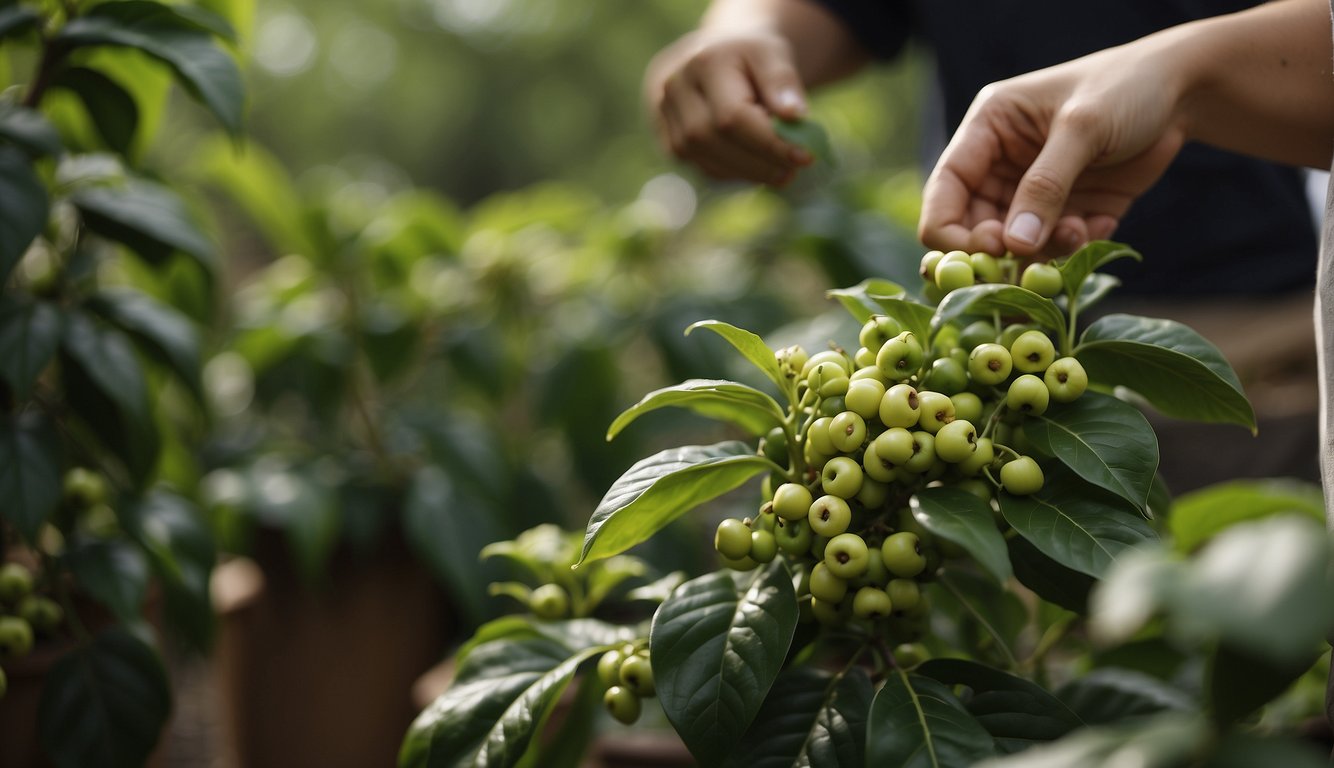
Encouraging Flowering
Coffee plants typically start to flower in the spring, and the bloom time can last for several weeks. The flowers are small and white, and they have a sweet fragrance.
To encourage your coffee plant to flower, you should make sure that it is getting enough light and water.
Coffee plants need bright, indirect light for at least 6 hours a day, and they should be watered regularly to keep the soil moist but not waterlogged.
You can also try pruning your coffee plant to encourage flowering. Pruning helps to promote new growth, which can lead to more flowers.
When pruning your coffee plant, make sure to use clean, sharp pruning shears, and cut back any dead or damaged branches.
You can also trim back the top of the plant to encourage it to branch out and produce more flowers.
Harvesting Coffee Cherries
After the flowers have bloomed and fallen off, small green coffee cherries will start to appear on the plant. These cherries will gradually darken from green to yellow, then to orange, and finally to a deep red color when they are ripe.
It is important to wait until the cherries are fully ripe before harvesting them, as unripe cherries will not have developed their full flavor.
To harvest the coffee cherries, simply pick them off the plant by hand. You can also use a pair of pruning shears to cut off the entire branch that the cherries are growing on.
Once you have harvested the cherries, you will need to remove the pulp and allow the beans to dry before roasting them.
Safety and Precautions – Growing Coffee Plants Indoors

As with any plant, it is important to be aware of any potential safety concerns when growing coffee plants indoors. In this section, I will cover some of the most important safety and precautions to keep in mind.
Toxicity to Pets and Humans
Coffee plants belong to the Rubiaceae family, which contains many species that are toxic to both pets and humans. While the toxicity of coffee plants is relatively low, it is still important to be aware of the potential risks.
The leaves and beans of the coffee plant contain caffeine, which can cause a range of symptoms in pets and humans if ingested in large quantities. These symptoms can include restlessness, vomiting, and even seizures in severe cases.
To minimize the risk of toxicity, it is important to keep coffee plants out of reach of pets and children.
If you have pets or young children in your home, consider placing your coffee plant on a high shelf or in a room that is off-limits to them.
Safe Handling and Care
In addition to the potential toxicity of coffee plants, there are also some general safety precautions to keep in mind when handling and caring for them.
One of the most important things to keep in mind is that coffee plants are susceptible to a range of diseases, including fungal and bacterial infections.
To prevent the spread of disease, it is important to use clean, sterilized tools when pruning or repotting your coffee plant.
Another important safety consideration is the use of pesticides and other chemicals.
While it may be tempting to use these products to control pests or diseases, it is important to remember that they can be toxic to both pets and humans.
Instead, consider using natural pest control methods, such as neem oil or insecticidal soap.
Finally, it is important to remember that coffee plants require a certain level of care to thrive.
This includes regular watering, fertilizing, and pruning.
If you are new to gardening or are unsure of how to care for your coffee plant, consider consulting with a professional or doing some research online to ensure that you are providing the best possible care for your plant.
Environmental Considerations – Growing Coffee Plants Indoors

Growing coffee plants indoors requires attention to environmental conditions to ensure the plants thrive. Here are some important environmental considerations to keep in mind:
Using Organic Practices
I prefer to use organic practices when growing my coffee plants indoors.
This means avoiding the use of synthetic fertilizers, pesticides, and herbicides.
Instead, I use natural fertilizers such as compost or worm castings to provide nutrients to the plants.
I also make sure to keep the plants healthy by providing them with the right amount of water and sunlight.
Creating a Microclimate – Growing Coffee Plants Indoors
Creating a microclimate around the coffee plants can help them grow well.
One way to do this is by placing a plastic bag over the pot to lock in humidity while the plant grows roots, as suggested by Better Homes & Gardens. Once the plant is established, I remove the bag.
I also make sure to keep the plants away from drafts and direct sunlight, as this can damage the leaves.
Another way to create a microclimate is by using a greenhouse.
A greenhouse can help regulate the temperature, humidity, and light levels around the plants, providing an ideal environment for coffee production.
However, it’s important to make sure the greenhouse is well-ventilated to prevent the plants from overheating.
Growing Coffee Plants Indoors: A Herbalist’s Brew-tiful Guide
Today, we’re brewing up some knowledge about growing coffee plants indoors. Yes, you heard it right! Your very own coffee, right at home.
Coffee plants are not just about the beans. They’re beautiful houseplants with glossy green leaves that can add a tropical touch to your home. And the best part? They’re surprisingly easy to grow!
Now, let’s spill the beans on how to grow them. Coffee plants love bright, indirect light and humid conditions. So, a well-lit bathroom could be the perfect spot. They also prefer well-draining soil and a consistent watering schedule. Remember, no soggy roots!
But here’s the fun part. Once your coffee plant starts flowering, you’ll see coffee cherries. Inside these cherries are the coffee beans. Imagine roasting your own home-grown coffee beans. Now, that’s a cup of joe worth waiting for!
Want more tips on growing plants indoors? Head over to my website, theherbprof.com. It’s packed with herbal wisdom and gardening tips.
So, ready to brew some knowledge and grow your own coffee plant? Let’s get planting!
References – Growing Coffee Plants Indoors
Little Herb Encyclopedia, by Jack Ritchason; N.D., Woodland Publishing Incorporated, 1995
The Ultimate Healing System, Course Manual, Copyright 1985, Don Lepore
Planetary Herbology, Michael Tierra, C.A., N.D., Lotus Press, 1988
Handbook of Medicinal Herbs, by James A. Duke, Pub. CRP Second Edition 2007
The Complete Medicinal Herbal, by Penelope Ody, Published by Dorling Kindersley
Check the Following Articles!
DIY Worm Bin: How to Create Your Own Vermicomposting?
Can You Eat a Tomato with Seeds Sprouting Inside?
Adding Bokashi to Compost Bin: A Simple Guide
Are Crab Apples Edible? What You Need to Know
Frequently Asked Questions – Growing Coffee Plants Indoors

What are the ideal conditions for growing a coffee plant indoors?
Coffee plants thrive in warm, humid environments with bright, indirect light. The ideal temperature range for growing coffee plants is between 60-80°F. Additionally, coffee plants prefer a soil pH between 6.0 and 6.5.
How do I properly care for a coffee plant as a houseplant?
Watering is crucial for coffee plants, but it is important not to overwater them.
The soil should be kept moist, but not waterlogged. Coffee plants also require high humidity levels, so it is recommended to mist the leaves regularly.
Pruning can help maintain the plant’s shape and encourage new growth.
What type of potting mix is best for indoor coffee plants?
A well-draining, nutrient-rich potting mix is best for coffee plants.
The soil should be kept moist, but not waterlogged. Adding organic matter, such as compost or peat moss, can help increase the soil’s nutrient content.
How long does it typically take for an indoor coffee plant to produce fruit?
It can take up to 3-4 years for an indoor coffee plant to produce fruit. Factors such as lighting, temperature, and humidity can affect the plant’s growth rate and fruit production.
What are the common growth stages of a coffee plant when cultivated indoors?
Coffee plants go through several growth stages, including germination, seedling, vegetative, and reproductive. During the vegetative stage, the plant will produce leaves and branches, while the reproductive stage is when the plant produces flowers and fruit.
What kind of fertilizer should be used for coffee plants grown inside?
A balanced, water-soluble fertilizer with equal amounts of nitrogen, phosphorus, and potassium is recommended for coffee plants.
Fertilizer should be applied every 2-3 months during the growing season.
Over-fertilization can damage the plant, so it is important to follow the manufacturer’s instructions.
